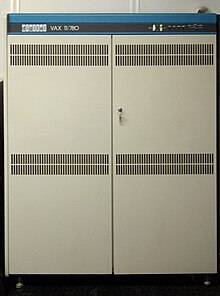1978
| |||||||||||||||||||||||||||||||||||||||||||||||||||||||||||||||||||||||||||||||||||||||||||||||||||||||||||||||||||||||||||||||||||||||||||||||||||||||||||||||||||||||||||||||||||||||||||||||||||||||||||||||||||||||||||||||||||||||||||||||||||||||||||||||||||||||||||||||||||||||||||||||||||||||||||||||||||||||||||||||||||||||||||||||||||||||||||||

VAX 11/780
VAX-11/780[edit]
The VAX-11/780 supported 128 kB to 8 MB of memory (2MB initially) through one or two memory controllers. Each memory controller supported 128 kB to 4 MB of memory. The memory was constructed from 4 or 16 kbit metal oxide semiconductor (MOS) RAMs mounted on memory array cards. Each memory controller controlled up to 16 array cards. The memory was protected by error correcting code (ECC). The VAX-11/780 used the Unibus and Massbus for I/O. Unibus was used for attaching peripherals and Massbus for disk and tape drives. Both buses were provided by adapters that interfaced the bus to the SBI. All systems came with one Unibus as standard, with up to four supported. Massbus was optional, with up to four supported. The VAX-11/780 also supported Computer Interconnect (CI), a proprietary network to attach disk drives and potentially share them with other VAX computers. Later, this feature was used to connect VAX computers in a VMScluster. VAX-11/782[edit]
The VAX 11/782, code-named "Atlas",[2] was a dual-processor VAX-11/780 introduced in 1982. Both processors shared the same MA780 multiport memory bus and the system operated asymmetrically with the primary CPU performing all I/O operations and process scheduling with the second, attached processor only used for additional computationally-intensive work. For multistream computation-intensive tasks the system delivered up to 1.8 times the performance of a VAX 11/780.
|  | The VAX 11/780 from Digital Equipment Corp. featured the ability to address up to 4.3 gigabytes of virtual memory, providing hundreds of times the capacity of most minicomputers | |||||||||||||||||||||||||||||||||||||||||||||||||||||||||||||||||||||||||||||||||||||||||||||||||||||||||||||||||||||||||||||||||||||||||||||||||||||||||||||||||||||||||||||||||||||||||||||||||||||||||||||||||||||||||||||||||||||||||||||||||||||||||||||||||||||||||||||||||||||||||||||||||||||||||||||||||||||||||||||||||||||||||||||||||||||||||||
Wednesday, June 10, 2015
The VAX 11/780 from Digital Equipment Corp 1978
Subscribe to:
Post Comments (Atom)

No comments:
Post a Comment